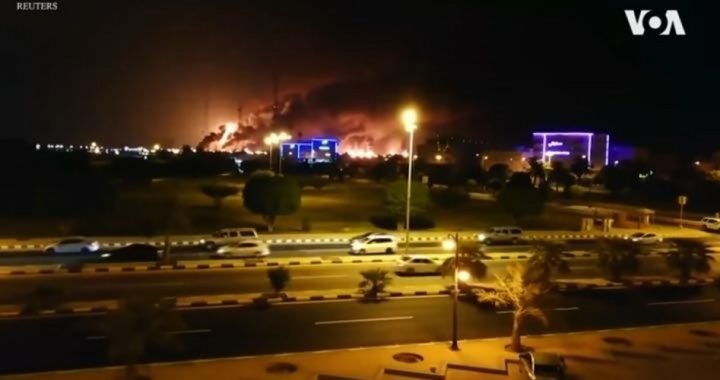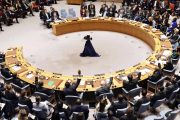
Back on September 16, we reported that the Trump administration had issued strong statements in response to the September 14 coordinated strikes on the world’s largest oil processing facility and a nearby oil field in Saudi Arabia. Soon after the strike, Secretary of State Mike Pompeo charged that Iran was behind what he called “an unprecedented attack on the world’s energy supply.”
“Tehran is behind nearly 100 attacks on Saudi Arabia while [President Hassan] Rouhani and [Foreign Minister Mohammad] Zarif pretend to engage in diplomacy,” Pompeo tweeted. “There is no evidence the attacks came from Yemen.”
Now, on November 25, both Fox News and Reuters reported that emerging evidence indicates that Iran was responsible for the attacks on the Saudi refineries. Reuters, which broke the story, had contact with three officials familiar with meetings held last May by Iranian security officials at a heavily fortified compound in Tehran, where they plotted the attack on Saudi Aramco, Saudi Arabia’s state-controlled oil company. A fourth official close to Iran’s decision makers also spoke with Reuters.
The group meeting in Tehren last May included high-ranking members of the Islamic Revolutionary Guard Corps, an elite branch of the Iranian military responsible for missile development and covert operations.
The most important matter discussed at that meeting was how to punish the United States after President Trump announced the U.S. pullout of the 2015 Iran nuclear deal framework. In June, Trump announced new sanctions against Iran, in part to retaliate after Iran shot down a U.S. drone.
A senior commander of the Islamic Revolutionary Guards took the floor at the meeting and said: “It is time to take out our swords and teach them [the Americans] a lesson.”
Some hard-liners in the meeting even suggested attacking high-value targets, including U.S. military bases.
However, cooler heads prevailed and the attendees recognized that any such attack would inevitably provoke a devastating U.S. response.
Instead, the Revolutionary Guard leaders decided to target oil installations in Saudi Arabia, a strong U.S. ally.
Reuters cited statements from the officials familiar with the meetings confirming that Iran’s Supreme Leader Ayatollah Ali Khamenei approved the operation, but insisted that Iranian forces avoid hitting any civilians or Americans.
More than 100 contractors fled the site following the attack, in which there were no injuries, the Associated Press reported in September.
Iran still denies that it played any role in the September 14 strikes against the oil processing facility and oil field in Saudi Arabia.
Alireza Miryousefi, spokesman for the Iranian Mission to the United Nations in New York, denied that the version of events described to Reuters was correct and said that no meetings of Iran’s top security officials took place to discuss such an operation, and that Khamenei did not authorize any attack.
“No, no, no, no, no, and no,” Miryousefi said to multiple questions posed to him by Reuters about the alleged gatherings and Khamenei’s purported approval of the agenda.
In our September 16 article, we noted that the Iranian-backed Houthi militia in Yemen claimed responsibility for the strikes but, as noted above, Pompeo insisted that there was “no evidence the attacks came from Yemen.”
Houthi spokesman Yahia Sarie said in a short address aired by Houthi’s Al-Masirah satellite news channel that the group launched 10 drones in a coordinated attack on the sites. “The only option for the Saudi government is to stop attacking us,” he added.
However, a September 15 Bloomberg report cited two unnamed senior U.S. administration officials who said that there is no doubt Iran was behind the attacks on Saudi oil, claiming that there is evidence that the location and weapons used were beyond the capability of the Houthi rebels in Yemen.
These latest reports indicate that the U.S. assessment back in September was correct.
Image of attack aftermath: Screenshot of YouTube video by Reuters via Voice of America news
Related articles:
Pompeo Blames Iran for Attack on Saudi Refineries; Trump Awaits Saudi Assessment
China Set to Sell Weaponized Drones to Saudi Arabia
Houthi Rebel Missile Fired at Ridyadh Intercepted by U.S.-supplied Patriot Missile
U.S. Fleet to Intercept Iranian Ships Bound for Yemen
Keeping Track of Militant Islamic Groups
Iran Says Saudis Must Stop “Criminal Acts” in Yemen
Warren Mass has served The New American since its launch in 1985 in several capacities, including marketing, editing, and writing. Since retiring from the staff several years ago, he has been a regular contributor to the magazine. Warren writes from Texas and can be reached at [email protected].



